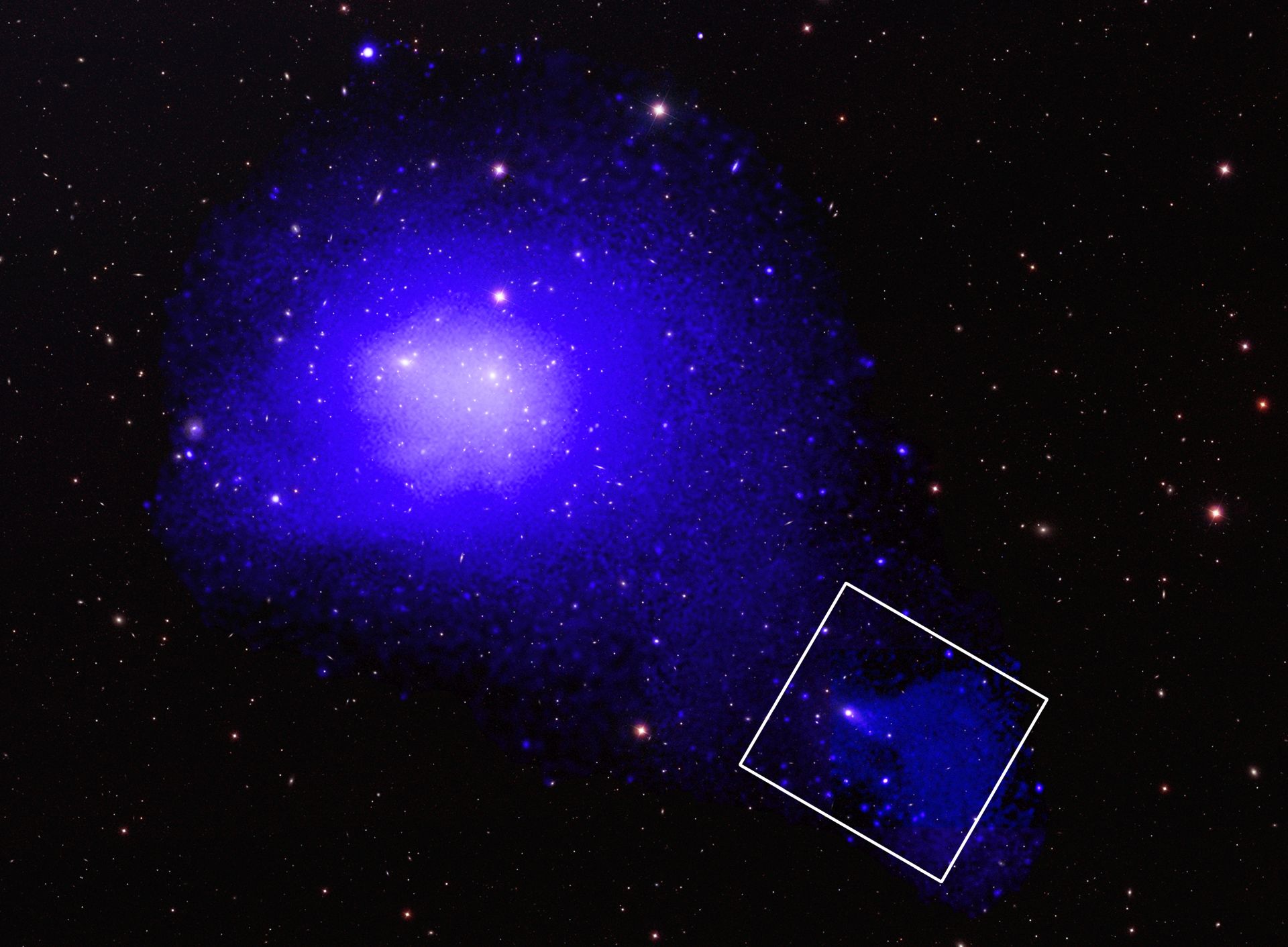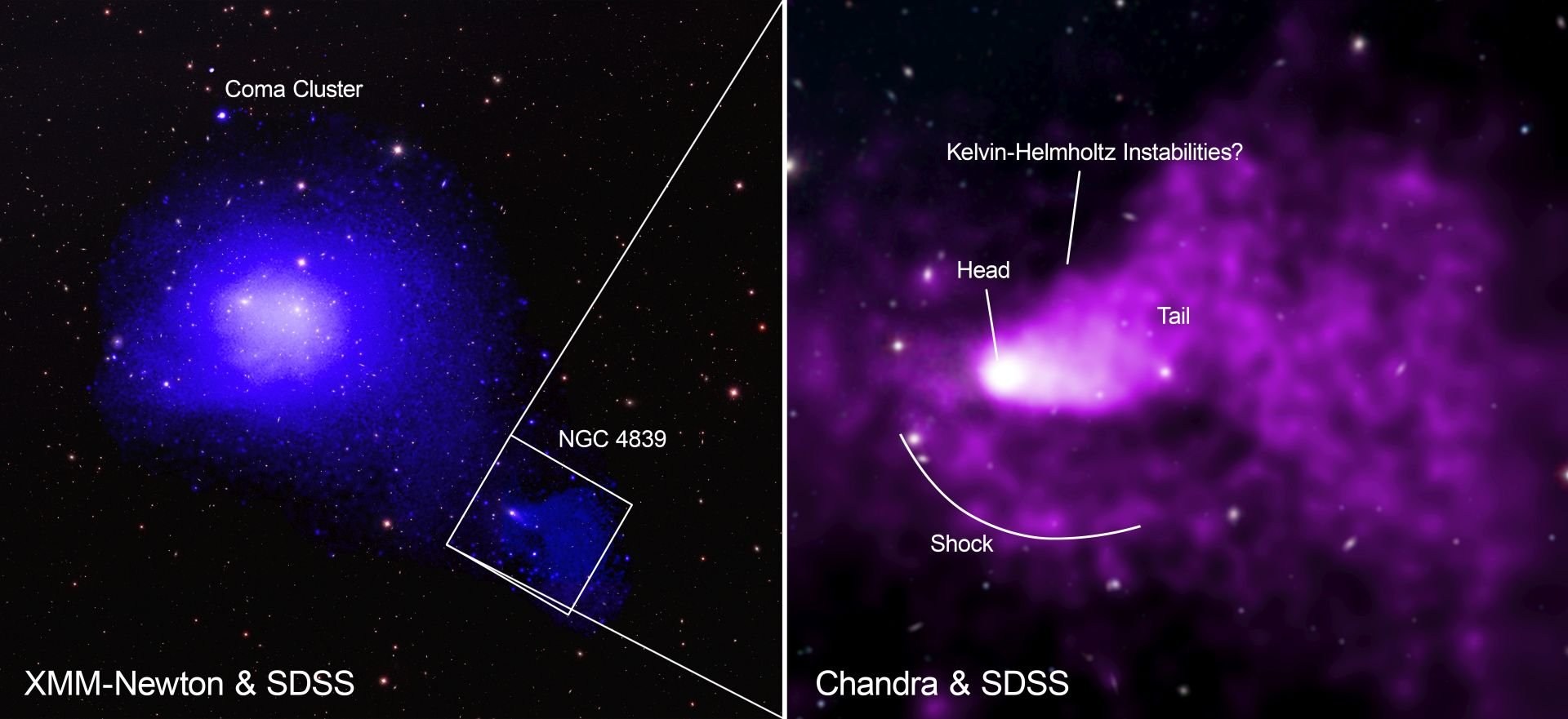A group of galaxies is plunging into the Coma galaxy cluster and leaving behind an enormous tail of superheated gas.

Coma cluster of galaxies. Image credit: X-ray: Chandra: NASA/SAO/Univ. of Alabama/M. S. Mirakhor et al.; XMM: ESA/XMM-Newton; Optical: SDSS; Image processing: N. Wolk
Astronomers have confirmed this is the longest known tail behind a galaxy group and used it to understand better how galaxy clusters – some of the largest structures in the universe – grow to their enormous sizes.
Astronomers trained NASA’s Chandra X-ray Observatory on the galaxy group NGC 4839. Groups of galaxies are collections of about 50 galaxies or less bound by gravity. Galaxy clusters are even larger and can contain hundreds or thousands of individual galaxies.
Both galaxy clusters and galaxy groups are enveloped by huge amounts of hot gas that are best studied using X-rays. Though extremely thin and diffuse, these superheated pools of gas represent a significant portion of the mass in galaxy groups or clusters and are crucial for understanding these systems.

Coma cluster – labeled version. Image credit: X-ray: Chandra: NASA/SAO/Univ. of Alabama/M. S. Mirakhor et al.; XMM: ESA/XMM-Newton; Optical: SDSS; Image processing: N. Wolk
NGC 4839 is located near the edge of the Coma galaxy cluster, one of the largest known clusters in the universe about 340 million light-years away. As NGC 4839 moves toward the center of the Coma cluster, the hot gas in the galaxy group is stripped away by its collision with gas in the cluster. This results in a tail forming behind this group of galaxies.
The image on the left shows an X-ray view of the Coma galaxy cluster taken with ESA’s (European Space Agency’s) XMM-Newton (blue), along with optical data from the Sloan Digital Sky Survey (yellow). The galaxy group NGC 4839 is located in the lower right of that image.
The inset on the right is the Chandra image (purple) of the region outlined by the square. The head of NGC 4839’s tail is on the left side of the Chandra image and contains the brightest galaxy in the group and the densest gas. The tail trails to the right. (The Chandra image has been rotated so that north is about 30 degrees to the left of vertical.)

Coma cluster. Image credit: X-ray: Chandra: NASA/SAO/Univ. of Alabama/M. S. Mirakhor et al.; XMM: ESA/XMM-Newton; Optical: SDSS; Image processing: N. Wolk
X-rays from the hot gas in the outer regions of the Coma cluster — that NGC 4839 is traveling through — are too faint to be seen in the XMM image shown here, but are highlighted in a supplementary, XMM-only image.
This mosaic of images depicting the region containing multiple galaxies shows gaps between individual images where data was not obtained, and dark holes where point sources of X-rays were removed.
This tail is, in fact, 1.5 million light-years long, or hundreds of thousands of times the distance between the Sun and the nearest star, making it the longest tail ever seen trailing behind a group of galaxies.
The current brightness of the tail gives astronomers a special chance to study the physics of the tail’s gas before it mixes in with the hot gas in the cluster and becomes too faint to study. The gas in the tail behind NGC 4839 will ultimately merge with the large amount of hot gas already present in the Coma Cluster.
Using the Chandra data to analyze the gas in front of the galaxy group, the researchers found a shock wave – similar to a sonic boom from a supersonic jet – showing that NGC 4839 is traveling at about 3 million miles per hour through the galaxy cluster. The shock wave’s location is highlighted in a labeled version of the image.
They also studied the amount of turbulence in the tail’s gas. For a familiar analogy, turbulence describes the irregular air movements in our atmosphere that can make for bumpy rides on airplanes. They found a mild amount of turbulence, which implies that heat conduction in NGC 4839 is low.
The team also saw possible evidence for special structures called Kelvin-Helmholtz instabilities on one side of the tail. Scientists find these structures in various settings in space and on Earth, including in cloud shapes. They are caused by differences in speed of adjacent layers of moving gas or fluid.
The presence of Kelvin-Helmholtz instabilities in NGC 4839 suggest that the gas in the tail has a weak magnetic field or a low level of viscosity. (Water, for example, is less viscous than honey.)
The locations of the Kelvin-Helmholtz instabilities are given in a labeled Chandra image and a version of the Chandra image that has been processed to emphasize regions in the image with sharper edges.
Researchers looking at earlier observations of NGC 4839 had estimated its tail to be at least one million light-years long. The new Chandra data reveals the new record-holding 1.5 million light-years length. (Tails behind three other groups of galaxies falling into galaxy clusters are between 800,000 and one million light-years long.)

